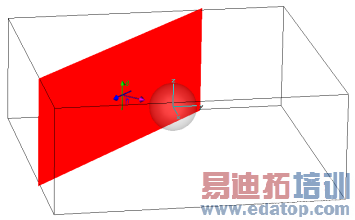- 易迪拓培训,专注于微波、射频、天线设计工程师的培养
CST2013: Plane Wave
 Simulation: Sources and Loads
Simulation: Sources and Loads  Plane Wave
Plane Wave
Within this dialog, you may define a plane wave excitation source. Unlike discrete ports or waveguide ports, no S-parameters will be calculated. Instead, the stimulation amplitude (unit is V/m) is recorded. To obtain further information, you might specify probes or different types of field monitors. Combined with farfield monitors, the plane wave source can be used to compute the radar cross section (RCS).
Polarization frame
Here, you may enter the polarization of the plane wave and polarization specific settings. For more information on the different polarization types, please see the Plane Wave Overview.
Linear / Circular / Elliptical: Select here the type of plane wave excitation polarization.
Ref. frequency: If the selected type is circular or elliptical, enter here the reference frequency for the plane wave excitation. This field only applies to elliptical and circular polarized plane wave excitations.
Phase Difference: Enter here the phase difference between the two excitation vectors for elliptical polarized plane waves. This field only applies to elliptical polarized plane wave excitations.
Left / Right: Select here between left circular polarized or right circular polarized plane wave excitation. These settings only apply to circular polarized plane wave excitations. The respective radio buttons are only visible if a circular polarization is selected.
Axial ratio: Defines the ratio between the amplitudes of the two electric field vectors used for elliptical polarization. This field only applies to elliptical polarized plane wave excitations.
Propagation normal frame
X/Y/Z: Here you can specify the propagation vector by entering valid expressions for the X/Y/Z component.
Electric field vector frame
X/Y/Z: Specify the electric field vector components in V/m. The electric field vector must be orthogonal to the propagation normal. If this is not the case, the user is asked if the electric field vector components should be automatically orthogonalized.
Please note that the input signal of an excited plane wave is normalized due to the defined absolute value of the electric field vector.
For a circular polarization, the length of the electric field vector defines the amplitude of the signal. For an elliptical polarization, the length and the direction of the electric field vector define the length and direction of the major axis. The length of the minor axis is computed from the axial ratio given by the user.
|
|
The definition of the plane wave is visualized by a red plane. Colored arrows indicate the propagation direction as well as the electric and magnetic field vectors. | Here the electric field vector of a plane wave is hitting a metallic sphere. Correspondent to the picture on the left side the plane wave is excited with an electric field vector in z-direction and a propagation normal (1,1,0). |
Decoupling plane frame
If a structure contains metallic walls dividing the calculation domain into two separate parts, it is necessary to consider a decoupling plane in the plane wave calculation. Note that this decoupling plane needs to be aligned with the Cartesian coordinate axes (see also: Plane Wave Overview ).
Automatic detection: The selection of this checkbox will automatically detect possible metallic walls and consequently activate the corresponding decoupling plane. This detection procedure only recognizes a metallic plane with no discontinuities at the boundary of the calculation domain. If the decoupling plane is not found, you may specify a decoupling plane using the input fields below.
Use decoupling plane: This checkbox is only available if the automatic detection is deselected. Activate here a user-defined decoupling plane defined by the following input fields.
Position: Set the position of the decoupling plane with respect to the plane normal by entering a valid expression. If the metal plane has a finite thickness, specify the surface of reflection.
Plane normal: Select a normal direction for the decoupling plane. Decoupling planes need to be aligned with the coordinate axes, so you can choose among X, Y or Z.
OK
Accepts your settings and leaves the dialog box.
Cancel
Closes this dialog box without performing any further action.
Help
Shows this help text.
Plane Wave Overview, Reference Value and Normalization
CST微波工作室培训课程套装,专家讲解,视频教学,帮助您快速学习掌握CST设计应用
上一篇:CST2013: Probe – Origin
下一篇:CST2013: Special Multilayer Solver Parameters
 最全面、最专业的CST微波工作室视频培训课程,可以帮助您从零开始,全面系统学习CST的设计应用【More..】
最全面、最专业的CST微波工作室视频培训课程,可以帮助您从零开始,全面系统学习CST的设计应用【More..】
频道总排行
- CST2013: Mesh Problem Handling
- CST2013: Field Source Overview
- CST2013: Discrete Port Overview
- CST2013: Sources and Boundary C
- CST2013: Multipin Port Overview
- CST2013: Farfield Overview
- CST2013: Waveguide Port
- CST2013: Frequency Domain Solver
- CST2013: Import ODB++ Files
- CST2013: Settings for Floquet B


